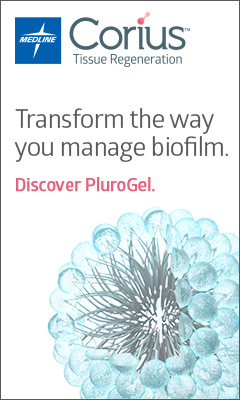Preventing and Treating Skin Injuries
Wound bed preparation
Wound bed preparation is the cornerstone to effective wound healing. A clear working knowledge of its principles is essential.
Wounds generally go through four relatively distinct but overlapping phases in the process of healing: hemostatic, inflammatory, proliferative and remodeling. They usually proceed in an orderly and stepwise fashion, but when this process is interrupted, whether by intrinsic or extrinsic factors, it becomes incumbent on the clinician to understand and practice effective wound bed preparation. This involves the use of appropriate techniques and products applied in a timely and appropriate manner.
It is useful to view this process through a paradigm that encompasses the important tenets of wound bed preparation. Such a paradigm can be found in DIMES, coined by Gary Sibbald, M.D., in Toronto, Ontario, Canada.

What is DIMES?
D – Debridement
Debridement is perhaps the most important step in wound bed preparation, and the most efficient and effective method is sharp debridement with a surgical instrument. This process, in appropriately skilled hands, leads to the most timely and complete removal of necrotic tissue, foreign bodies, callus and senescent cellular material.
There is abundant literature to support the fact that sharp debridement is an effective biofilm management strategy. However, while a one-time debridement may remove biofilm, we cannot be sure if it is completely removed. Sharp debridement is not a permanent treatment given that biofilm can reform in as little as 48 to 72 hours.
I – Infection and bioburden
Infection is an encompassing term used to describe the spectrum of bioburden in the wound bed—from contamination through frank wound infection and including planktonic and biofilm bacteria, as well as cellulitis and osteomyelitis. We must understand how to effectively assess the degree of bioburden and infection.
We also must know how to treat it in the most efficacious manner, while minimizing microbial resistance due to injudicious or inappropriate antibiotic usage. Systemic antibiotics, topical antimicrobials and dressings containing antimicrobials are among our many choices.
M – Moisture balance
Moisture balance addresses the appropriate management of moisture in the wound bed. It is accepted without question that a moist wound environment is essential for healing. Indeed, an intact blister is the ideal physiologic and anatomic model for moist wound healing.
Wounds that are too dry will benefit from moist topicals such as hydrogels, medicinal honeys and surfactant compounds, and from moisture-retentive dressings such as film dressings and hydrocolloids. Wounds that are too wet due to excessive drainage or exudate will benefit from absorptive dressings such as alginates, gelling fibers and foams.
E – Epithelialization
Epithelialization is essential for ultimate wound closure. It cannot occur without a clean epithelial wound edge and a clean wound bed free of necrotic tissue, fibrin and cellular debris. Undermining, hyperkeratosis, callus and epibole should all be eliminated to the extent possible to allow for unrestricted epithelial migration.
There are myriad cellular- and tissue-based products (CTPs) available that can be used to facilitate epithelialization. It must be remembered, however, that with few exceptions, these products are constructs that release cells and growth factors. But they are not grafts and should not be expected to “take” or incorporate similar to a skin graft.
S – Surrounding skin
Surrounding skin reminds us to exercise caution with products and dressings to keep periwound skin healthy and intact. Examples of common problems are poorly managed exudate or moist topicals that can create periwound maceration, as well as tapes and other adhesives leading to medical adhesive related skin injury (MARSI).
Wound healing is an elegantly orchestrated anatomic and physiologic process. When unimpeded, healing proceeds to wound closure with little or no intervention. When wounds stall and become chronic, however, there is a very real and necessary need for our intervention.
While these interventions may include things such as improving glycemic control and mitigating various medical and pharmacologic comorbidities, a critical and often rate-altering step is aggressive and appropriate wound bed preparation.

Lee C. Ruotsi, MD, ABWMS, CWS-P, UHM, is medical director of the Catholic Health Advanced Wound Healing Program in Buffalo, New York. He also is fellowship program director for the Wound Care Fellowship. He is a clinical consultant to Medline Industries.

